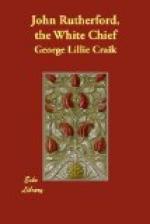Although there are no written laws in New Zealand, all these matters are, no doubt, regulated by certain universally understood rules, liberal enough in all probability, in the license which they allow to the tyranny of the privileged class, but still fixing some boundaries to its exercise, which will accordingly be but rarely overstepped. Thus, the power which the chief seems to enjoy of depriving any of his slaves of life may be limited to certain occasions only; as, for instance, the death of some member of the family, whose manes, it is conceived, demand to be propitiated by such an offering. That in such eases slaves are often sacrificed in New Zealand, we have abundant evidence.
Cruise even informs us that when a son of one of the chiefs died in Marsden’s house, in New South Wales, it required the interposition of that gentleman’s authority to prevent some of the boy’s countrymen, who were with him, from killing a few of their slaves, in honour of their deceased friend. On other occasions, it is likely that the life of the slave can only be taken when he has been convicted of some delinquency; although, as the chief is the sole judge of his criminality, he will find this, it may be thought, but a slight protection. The domestic slaves of the chiefs, however, it is quite possible, and even likely, are much more completely at the mercy of their caprice and passion than the general body of the common people, whose vassalage may, after all, consist in little more than the obligation of following them to their wars, and rendering them obedience in such other matters of public concern.
Between the chiefs and the common people, who, as we have already mentioned, are called “cookees,” there seems to be also a pretty numerous class, distinguished by the name of rungateedas, or, as it has been more recently written, rangatiras, which appears to answer nearly to the English term gentry.[AX] It consists of those who are connected by relationship with the families of the chiefs; and who, though not possessed of any territorial rights, are, as well as the chiefs themselves, looked upon as almost of a different species from the inferior orders, from whom they are probably as much separated in their political condition and privileges as they are in the general estimation of their rank and dignity. The term rangatira, indeed, in its widest signification, includes the chiefs themselves, just as our English epithet gentleman does the highest personages in the realm.
Although there is no general government in New Zealand, the chiefs differ from each other in power; and some of them seem even to exercise, in certain respects, a degree of authority over others. Those who are called areekees,[AY] in particular, are represented as of greatly superior rank to the common chiefs. It was, probably, a chief of this class of whom Cook heard at various places where he put in along the east coast of the northern island, on his first visit to the country. He calls him Teratu; and he found his authority to extend, he says, from Cape Turnagain to the neighbourhood of Mercury Bay. The eight districts, too, into which this island was divided by Toogee,[AZ] in the map of it which he drew for Captain King, were in all likelihood the nominal territories, or what we may call feudal domains, of so many areekees.




